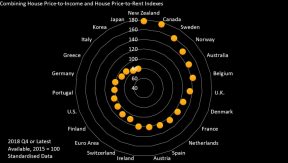Policymakers in Canada have tried repeatedly in recent years to tame the country’s housing market, and with national home prices and sales subdued, the effort seems to be paying off.
Tougher federal mortgage rules and localized measures — such as foreign homebuyer taxes in the Toronto and Vancouver areas — have helped create cooler conditions.
But the Canadian housing market isn’t in the clear just yet, research from Bloomberg Economics suggests.
In fact, Niraj Shah, an economist and editor for Bloomberg, says Canada is still among the riskiest markets in the world right now.
“Canada and New Zealand are the most vulnerable to a house price correction given both the price-income ratio and the price-rent ratio are well above their long-run averages, according to Bloomberg Economics,” writes Shah in a Bloomberg article discussing his so-called “housing bubble dashboard,” which measures housing-market risks in 23 countries.

Shah has also flagged markets in Australia, Norway, Sweden and the UK.
One typical sign of a housing bubble is when home prices are out of whack with market fundamentals, such as local incomes, employment, and population growth.
That’s exactly what led Douglas Porter, the chief economist of BMO, to declare in winter 2017 that the GTA market was in bubble territory.
The ratios of home prices to income and home prices to rent that Shah examined for his bubble dashboard, then, are helpful in diagnosing a potential bubble.
Shah acknowledges that in both Canada and New Zealand, governments have cracked down on potential bubble-inducing foreign investment — but it may not be enough in the current economic climate.
“Still, the next challenge will be whether global house prices rise as central banks get ready to lower interest rates, with the federal reserve set to cut rates for the first time in more than a decade on Wednesday,” says Shah.
Cheaper credit can contribute to dangerous home price inflation, as it encourages borrowing.
Beginning in the summer 2017, the Bank of Canada started increasing its policy rate, which influences the mortgage market. By October 2018, the central bank had hiked its policy rate five times.
But a weaker-than-expected economy caused the bank to change course after that, and now some are calling for the bank’s next rate move to be a cut amid international trade uncertainties.
“There’s a risk that a global round of monetary easing may fuel housing bubbles,” says Shah in a separate Bloomberg article published earlier this month.
“While central bankers are focused on avoiding a global economic downturn, looser monetary policy could sow the seeds of the next crisis,” he adds.
According to Bloomberg : Despite Stricter Policies, Canada’s Housing Market Still a Bubble Risk by Josh Sherman | Livabl


Recent Comments